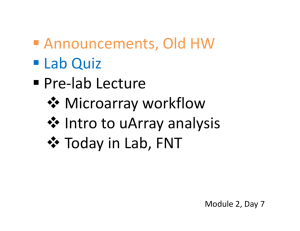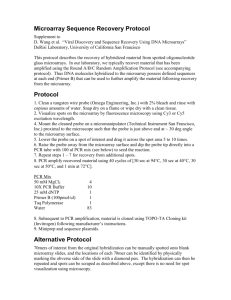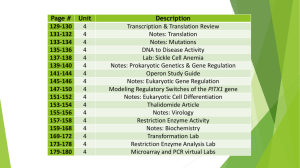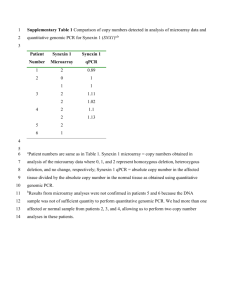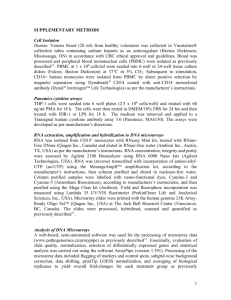GAMIDI MTKD-CT-2005-029774
advertisement
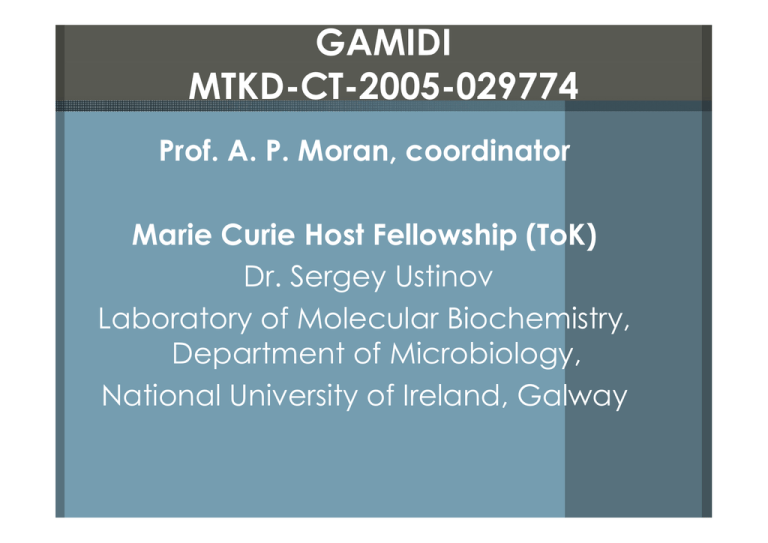
GAMIDI MTKD-CT-2005-029774 Prof. A. P. Moran, coordinator Marie Curie Host Fellowship (ToK) Dr. Sergey Ustinov Laboratory of Molecular Biochemistry, Department of Microbiology, National University of Ireland, Galway Information about Researcher: Professional Experience: Graduated: Novosibirsk Medical Academy (1998) Research Scientist in the Institute of Internal Medicine, Siberian Branch of the Russian Medicine Academy of Sciences, Novosibirsk, Laboratory of Molecular Genetics Therapeutic Diseases. George Mason University: Research assistant in the Center for Biomedical Genomics and Informatics, Fairfax, VA, USA Project: “Fetal hemoglobin expression in adipose tissue of morbidly obese” Auburn University: Research fellow in the Department of Pathobiology, AL, USA Project: “Phage microarray” Information about Researcher: Areas of Expertise: MICROARRAY TECHNIQUE: Analysis of Gene Expression using cDNA microarray technology: DNA/Protein/phage microarray. Microarray design. Data analysis. Experience in operating different microarray spotting robots. MOLECULAR BIOLOGY: RNA/DNA/proteins extraction from various tissues and microorganisms: blood, myocardium, adipocytes, spleen, liver, bone, gram negative and positive bacteria's. PCR/RT-PCR, Real-Time/Quantitative PCR , sequencing (automatic and manual, result processing), DNA/protein electrophoresis. Experience using molecular biological software: Oligo, Vector-NTI, DNA-star, MegAlign, Chromas, and others Information about the project Iron and pH-regulated gene expression of Helicobacter pylori To extend our knowledge of the process of regulation and adaptation in H. pylori with respect to two conditions; iron limitation and low pH, which are known to oscillate within the gastric mucosa, we are using cDNA microarrays to identify genes whose expression are dependant on changes in iron concentration and pH. Information about the project Design of the Experiments and Methods Growth conditions: H. pylori strains 26695, J99 and AG1 were grown at 37°C under microaerobic conditions on Columbia agar plates containing 5% horse blood and Dent’s antibiotic supplement. Harvested growth from this medium is act as an inoculum for liquid cultures in Brucella Broth containing 10% horse blood serum at 37°C. Acid exposure experiments: Bacteria from a liquid culture were harvested by centrifugation and were resuspended in liquid culture whose pH has been adjusted to pH 5.0 with hydrochloric acid. Incubation at 37°C under microaerobic conditions will continued for 1 h. Iron exposure experiment: Iron-restricted conditions were achieved by supplementing the brucella broth with 20 uM desferal (desferrioxamine-B; Sigma). Iron-sufficient conditions will be achieved by the absence of desferal. Samples were subsequently used for RNA isolation and microarray analysis. Information about the project Design of the Experiments and Methods Liquid culture Liquid culture Isolate total RNA Isolate total DNA Reverse Transcribe to label with Cy3 cDNA, label with Cy5 Mix, Hybridize and Scan Information about the project Real-time PCR confirmation: Unique primers will be designed for 100to 300-bp regions of selected up- and down-regulated genes seen in the array. Primer design will be aided by the Vector NTI software. Information about the project Work in progress Adjusted growing conditions. RNA extraction protocol: TRIzol® Max. Bacterial RNA Isolation Kit (Invitrogen) protocol was modified. Gel electrophoresis of the purified Helicobacter Pylori RNA shows distinct 16S and 23S ribosomal bands. DNA extraction protocol: Wizard® Genomic DNA Purification Kit (Promega) was modified. Strain-specific PCR and Sequencing protocol: Platinum® PCR SuperMix protocol, primers were designed by author. QIAquick PCR Purification Kit (QIAGEN) Confirmation of the strain (26695 and J99) by the sequencing and strain-specific PCR: Chromas and MegAlign software Information about the project Work in progress Microaaray protocol: The Bacterial Microarray Group at St George's, University of London (BµG@S) The Helicobacter pylori array has been designed to target the two sequenced strains. The base strain was selected as H.pylori 26695 and to this were consecutively added extra genes from strains J99 Future Prospects Campylobacter jejuni gene expression in response to iron limitation, growth temperature variation and low-oxygen environment. •There is a fast growing interest to the Campylobacter jejuni as a zoonotic pathogen. •Responsible for the majority of cases of bacterial enteritis world-wide. •Transmission to humans occurs through the consumption of contaminated food, especially poultry, milk and water. •Campylobacter enteritis is characterised by the destruction of the mucosal surfaces of the jejunum, ileum and colon. •Symptoms: diarrhea (can sometimes be bloody) also extra-intestinal symptoms: fever, headache and myalgia. Future Prospects Campylobacter jejuni gene expression in response to iron limitation, growth temperature variation and low-oxygen environment. •C.jejuni array is a PCR product array based on the NCTC 11168 strain annotation as described in Parkhill et al (2000) Nature 403: 685-688. •In addition to 1654 primer pairs designed to the NCTC 11168 strain, a further 73 primer pairs were designed to amplify selected genes from strains 81116, 81176, 11351, 11828, 2523/90, 43431, 43432, 43438, 43449, 43456, 460, 8F169, P19 and CjX. The Bacterial Microarray Group at St George's, University of London (BµG@S) Interesting points of collaboration with others in group New type of microarray construction. Analyzing the dynamic bacterial glycome with a lectin microarray approach (Nature Chemical Biology 2, 153-157 (2006) ) lectin microarray consisted of a panel of 21 lectins a) Bacteria bind to the lectin microarray through the interaction of bacterial surface carbohydrates with the lectin. (b) Fluorescent labeling of bacterial strains and hybridization to the array give distinct binding patterns.
